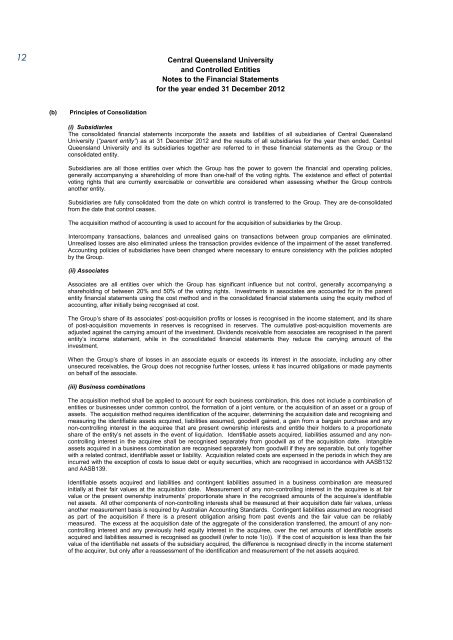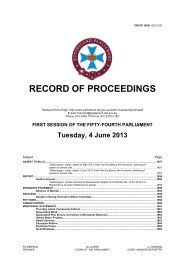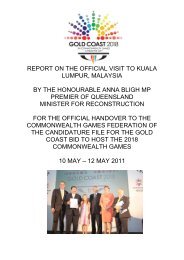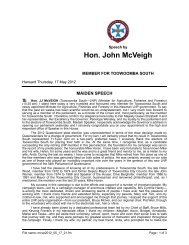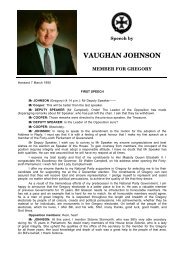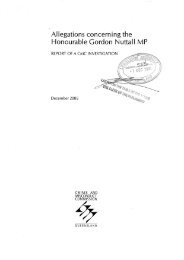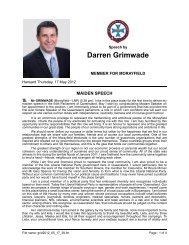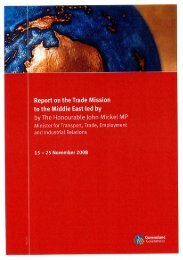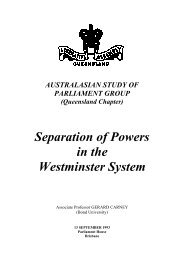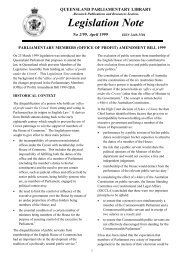CQUniversity Annual Report - Central Queensland University
CQUniversity Annual Report - Central Queensland University
CQUniversity Annual Report - Central Queensland University
Create successful ePaper yourself
Turn your PDF publications into a flip-book with our unique Google optimized e-Paper software.
12<br />
<strong>Central</strong> <strong>Queensland</strong> <strong>University</strong><br />
and Controlled Entities<br />
Notes to the Financial Statements<br />
for the year ended 31 December 2012<br />
(b)<br />
Principles of Consolidation<br />
(i) Subsidiaries<br />
The consolidated financial statements incorporate the assets and liabilities of all subsidiaries of <strong>Central</strong> <strong>Queensland</strong><br />
<strong>University</strong> (“parent entity”) as at 31 December 2012 and the results of all subsidiaries for the year then ended. <strong>Central</strong><br />
<strong>Queensland</strong> <strong>University</strong> and its subsidiaries together are referred to in these financial statements as the Group or the<br />
consolidated entity.<br />
Subsidiaries are all those entities over which the Group has the power to govern the financial and operating policies,<br />
generally accompanying a shareholding of more than one-half of the voting rights. The existence and effect of potential<br />
voting rights that are currently exercisable or convertible are considered when assessing whether the Group controls<br />
another entity.<br />
Subsidiaries are fully consolidated from the date on which control is transferred to the Group. They are de-consolidated<br />
from the date that control ceases.<br />
The acquisition method of accounting is used to account for the acquisition of subsidiaries by the Group.<br />
Intercompany transactions, balances and unrealised gains on transactions between group companies are eliminated.<br />
Unrealised losses are also eliminated unless the transaction provides evidence of the impairment of the asset transferred.<br />
Accounting policies of subsidiaries have been changed where necessary to ensure consistency with the policies adopted<br />
by the Group.<br />
(ii) Associates<br />
Associates are all entities over which the Group has significant influence but not control, generally accompanying a<br />
shareholding of between 20% and 50% of the voting rights. Investments in associates are accounted for in the parent<br />
entity financial statements using the cost method and in the consolidated financial statements using the equity method of<br />
accounting, after initially being recognised at cost.<br />
The Group’s share of its associates’ post-acquisition profits or losses is recognised in the income statement, and its share<br />
of post-acquisition movements in reserves is recognised in reserves. The cumulative post-acquisition movements are<br />
adjusted against the carrying amount of the investment. Dividends receivable from associates are recognised in the parent<br />
entity’s income statement, while in the consolidated financial statements they reduce the carrying amount of the<br />
investment.<br />
When the Group’s share of losses in an associate equals or exceeds its interest in the associate, including any other<br />
unsecured receivables, the Group does not recognise further losses, unless it has incurred obligations or made payments<br />
on behalf of the associate.<br />
(iii) Business combinations<br />
The acquisition method shall be applied to account for each business combination, this does not include a combination of<br />
entities or businesses under common control, the formation of a joint venture, or the acquisition of an asset or a group of<br />
assets. The acquisition method requires identification of the acquirer, determining the acquisition date and recognising and<br />
measuring the identifiable assets acquired, liabilities assumed, goodwill gained, a gain from a bargain purchase and any<br />
non-controlling interest in the acquiree that are present ownership interests and entitle their holders to a proportionate<br />
share of the entity’s net assets in the event of liquidation. Identifiable assets acquired, liabilities assumed and any noncontrolling<br />
interest in the acquiree shall be recognised separately from goodwill as of the acquisition date. Intangible<br />
assets acquired in a business combination are recognised separately from goodwill if they are separable, but only together<br />
with a related contract, identifiable asset or liability. Acquisition related costs are expensed in the periods in which they are<br />
incurred with the exception of costs to issue debt or equity securities, which are recognised in accordance with AASB132<br />
and AASB139.<br />
Identifiable assets acquired and liabilities and contingent liabilities assumed in a business combination are measured<br />
initially at their fair values at the acquisition date. Measurement of any non-controlling interest in the acquiree is at fair<br />
value or the present ownership instruments’ proportionate share in the recognised amounts of the acquiree’s identifiable<br />
net assets. All other components of non-controlling interests shall be measured at their acquisition date fair values, unless<br />
another measurement basis is required by Australian Accounting Standards. Contingent liabilities assumed are recognised<br />
as part of the acquisition if there is a present obligation arising from past events and the fair value can be reliably<br />
measured. The excess at the acquisition date of the aggregate of the consideration transferred, the amount of any noncontrolling<br />
interest and any previously held equity interest in the acquiree, over the net amounts of identifiable assets<br />
acquired and liabilities assumed is recognised as goodwill (refer to note 1(o)). If the cost of acquisition is less than the fair<br />
value of the identifiable net assets of the subsidiary acquired, the difference is recognised directly in the income statement<br />
of the acquirer, but only after a reassessment of the identification and measurement of the net assets acquired.


